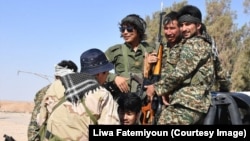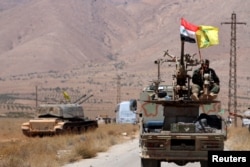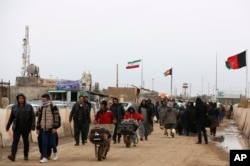With Syria's eight-year war waning, many foreign fighters who have fought in support of Syrian President Bashar al-Assad are returning to their home countries. Some of those fighters are Iranian-backed Afghan refugees.
Since 2011, Iran has sent thousands of undocumented Shi'ite Afghan refugees to Syria to fight alongside forces of the Lebanese militant group Hezbollah and Iran's elite Revolutionary Guard Corps (IRGC) forces.
These Afghan fighters are part of the Fatimiyoun Brigade, the second-largest group of foreigners fighting for Assad in Syria. At the peak of the war, media reports estimated they numbered between 10,000 and 12,000 fighters.
One of the returning Afghan fighters is 22-year-old Hamid, who commanded a unit within the Fatimiyoun Brigade. He said that he was 17 when he moved to Iran to find a job.
"After working there for six months, Iranian authorities gave me two options: Either go back to Afghanistan or fight in Syria," Hamid told VOA. "I chose to join the Fatimiyoun Brigade [in Syria] as I needed the money to pay off my debts."
Iran has recruited Afghan migrants to fight in Syria with promises of citizenship and improved living standards for their families. Roughly 3 million Afghans live in Iran, but many lack basic rights and live without a formal status in the country.
"I was promised Iranian citizenship, a $1,000 monthly salary, and the right to own a house and a car upon returning from Syria," said Hamid, who returned to Afghanistan in 2016. "But it was all a lie. I was granted a five-year residency, which required monthly renewal. I was not paid at all, let alone the right to own a house or a car."
Training
Before deploying to Syria in 2015, Hamid and other Afghan recruits received a month of military training at a mountainous location near the Iranian city of Yazd. He was then appointed by the IRGC to command a unit of 140 Afghan fighters in the Syrian province of Aleppo, where they fought Islamic militant groups such as al-Nusra Front, the former Syrian branch of the al-Qaida terror group.
"After six months of fighting in Syria, I got shot and returned to Iran," Hamid said. "I spent three months in Iran, but I was not treated. So I had to return to Afghanistan. My father sold a piece of his fertile land and sent me to India for treatment."
It is not clear how many Afghan fighters have returned home from Syria, though some estimates suggest numbers in the thousands.
Analysts believe that the Iranian military deployed Afghans in the Syrian war because it was less costly.
"For the Iranian regime, having these people killed in Syria is much less problematic than having Iranian citizens killed there," said Sadradeen Kinno, a Syrian researcher who closely follows militant groups in Syria.
"At least Iran didn't have to worry about a growing public outcry inside Iran over those Iranian-backed militiamen who were killed in Syria," he added.
Indoctrination
While the main incentive for many Afghan fighters to join the fight in Syria was financial, some have been indoctrinated by Iranian officials on a sectarian basis to fight the mostly Sunni rebels.
"Our aim was to clear Islam from those Takfiris [apostates] in Syria and later on in our homeland," a former Afghan fighter told VOA on the condition of anonymity because of security reasons.
He said that Afghan fighters "did not have any experience in fighting in mountainous areas as we were about to deploy to Latakia [province in western Syria]."
"Our commander told us, 'You better learn how to fight in the mountains so you will be well prepared for our future wars in Afghanistan in order to establish a real Islamic state,'" he added.
Threat to Afghanistan
Some experts charge that this extreme rhetoric and belief could pose a "real threat" to Afghanistan, an already volatile country.
These fighters "are definitely a threat to Afghanistan's security," said retired Afghan General Atiqullah Amarkhil. "They are a bunch of trained guerrillas who have fought as mercenaries [in Syria] and know nothing but fighting."
Amarkhil told VOA that most of the Afghan fighters who have fought in Syria are uneducated and "because of that they will either resort to robbery and killing or start a civil or sectarian war at the behest of Iran."
He said Afghan officials have often discussed this issue with the Iranian government, asking that it not return these fighters to Afghanistan because they are part of the Iranian Revolutionary Forces and need to be kept in Iran.
Hamid, the former fighter, voiced a similar concern.
"I have heard that some of the [Fatimiyoun Brigade] fighters are told they would be equipped to fight in Afghanistan," he said, adding that Iran has brainwashed them.
"The pretext could be fighting the Islamic State, but once inside Afghanistan these fighters would be tasked to fight the Afghan government," Hamid said.
Help during tough times
In a recent meeting with families of Afghan fighters, Iranian Supreme Leader Ayatollah Ali Khamenei said that many Afghans have helped the Islamic Republic during tough times.
"They helped us from the early days of [the Islamic] revolution, and during the imposed war [with Iraq], and now throughout the period of defending the Shrines [in Syria]," he said.
Iran has often said that its military presence in Syria is largely to protect Shi'ite holy sites there, while the U.S. and other Western countries say that Iran has played a major role in destabilizing Syria and other parts of the Middle East.
Backed by Iranian forces and Russian air power, Afghan fighters have played a major role in defending Syrian government forces across Syria, including decisive battles against rebels and Islamic State militants in Aleppo, Hama, Homs and Deir el-Zour.
"Some of them are still active in Syria, but less than before, I would say, because the security situation has improved for the Syrian government," said Aymenn Jawad al-Tamimi, a researcher at the Middle East Forum, a U.S.-based think tank.






